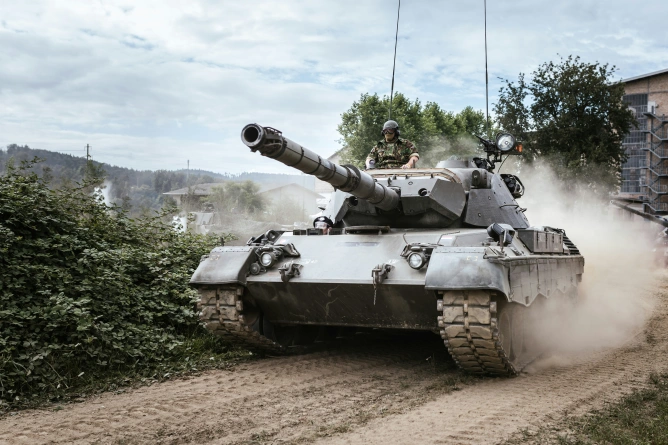
Brussels, November 19, 2025 – The European Union today presented the most ambitious package of measures in the defense sector in the last decade, aiming to create a European military mobility space by 2027 – already dubbed "military Schengen" – as well as launching a roadmap for transforming the European defense industry, intended to accelerate innovation, digitalization, and the production of critical technologies.
Executive Vice-President Henna Virkkunen, responsible for Technological Sovereignty, Security, and Democracy, described the launch of the package as a major paradigm shift:
"As we advance the European military mobility package, we are laying the foundations for a safer and more interconnected Europe. The lessons learned from Ukraine show us that the European defense industry must accelerate innovation and collaboration."
The package presented by the European Commission is built around three essential documents. The first is the Regulation on military mobility, a legislative act with direct applicability in all member states, designed to harmonize border crossing procedures and accelerate the movement of troops and equipment within the Union. The second document is the Joint Communication on the state of defense preparedness, which provides the strategic direction of the EU regarding military preparedness, operational integration, and cooperation among member states and is developed together with the High Representative of the Union for Foreign Affairs and Security Policy, Kaja Kallas, who emphasized the operational urgency of these measures:
"Rapid mobility is vital for the defense of Europe. We propose an emergency system for cross-border military transport and a mechanism for pooling member states' capabilities. The need for efficient military mobility is clearer than ever."
The third element is the EU Defence Industry Transformation Roadmap, which proposes modernizing the European industrial ecosystem through investments in advanced technologies such as artificial intelligence, drones, quantum systems, and space capabilities. The Commissioner for Defense and Space, Andrius Kubilius, explained the importance of this direction:
"A strong Europe needs both an adaptive and innovative defense industry and the ability to rapidly move its forces. Our goal is clear: a 'military Schengen' by 2027, allowing Europe to act as one."
Alongside these, the package also introduces new coordination structures at the European level, including a dedicated military transport group and digital information exchange mechanisms, as well as operational tools that support mobility, infrastructure resilience, and the increase of industrial capacities necessary for European defense.
The European Union also proposes to create a genuine "military Schengen" by 2027, by introducing the first common rules applicable in all member states for the movement of troops and military equipment. The proposed regulation reduces the processing time for cross-border transit requests to a maximum of 72 hours, replacing the current fragmented system, in which each member state applies its own procedures. Harmonizing these rules and simplifying military customs procedures will allow for faster, safer, and more coordinated movement of armed forces in crisis situations.
For emergency situations, the package establishes EMERS – the European Military Mobility Enhanced Response System. This mechanism activates accelerated procedures for approving military movements and grants priority access to critical infrastructure, including for operations conducted under the auspices of the EU or NATO. Essentially, EMERS functions as a "rapid response mode" of the Union, ensuring that the movement of troops and equipment can be carried out immediately when the security situation demands it.
The European Union will invest in modernizing its main transport corridors – the Trans-European Transport Network (TEN-T) – so that they are adapted to dual-use standards, meaning they can be safely used for both civil and military transport. This process of "smart militarization" of infrastructure aims to ensure that European roads, bridges, railways, and ports can support large volumes of heavy equipment and facilitate rapid movements of armed forces across the entire Union.
To protect these critical infrastructures and increase their resilience against possible attacks or disruptions, the Commission introduces a "resilience toolbox."
The Commissioner for Sustainable Transport and Tourism, Apostolos Tzitzikostas, highlighted the central role of this infrastructure:
"We rely on Europe's greatest strength – the TEN-T network – to enable rapid and unobstructed transport of troops and equipment. It is an investment in the security and economy of Europe."
The package includes measures for physical protection (such as strengthening structural elements), energy security (ensuring supply continuity and protecting networks), and cybersecurity (protecting digital systems that manage logistics and transport). The goal is for European infrastructure to remain functional and secure even in times of crisis, when rapid military mobility becomes essential.
To strengthen the capacity of member states to respond quickly in crisis situations, the package introduces a new cooperation mechanism: the "Solidarity Pool." This allows member states to pool and share military transport resources, from logistics platforms and means of transport to specialized equipment necessary for large-scale mobility. Through this system, the Union aims to reduce individual dependencies of states and create a common reserve that can be rapidly mobilized when operational conditions require it.
At the same time, to facilitate real-time coordination of military mobility, the Commission proposes the development of a European Digital Information System for Military Mobility. This will allow for the rapid and secure exchange of logistical information between member states, the Commission, and relevant military structures. The implementation of this framework will be overseen at the European level by a new body, the Military Mobility Transport Group, and by an enhanced TEN-T Committee, responsible for coordinating transport networks that support both civil and military mobility within the Union.
Lessons from Ukraine and the new European industrial paradigm
The war in Ukraine has demonstrated that the pace of evolution of military technologies is much faster than in traditional European industrial cycles, and the modern battlefield is dominated by systems based on artificial intelligence, drones, autonomous platforms, space capabilities, and quantum technologies. In light of this reality, the European Commission launches the EU Defence Industry Transformation Roadmap, a strategic plan aimed at connecting the European advanced technology ecosystem (deep tech) with the defense industry, to accelerate the emergence and adoption of new military capabilities.
The roadmap focuses on four priority directions: facilitating investments in defense companies, including emerging ones; accelerating the development of disruptive technologies that can transform how military systems are designed and used; expanding access to strategic capabilities so that member states can uniformly benefit from European innovations; and developing the skills necessary to sustain Europe's technological advantage in an increasingly competitive global environment.
The Commission emphasizes that Russia's aggression against Ukraine has exposed structural vulnerabilities of the European defense industry: fragmentation, slow production pace, insufficient scaling capacity, and external technological dependencies. The proposed roadmap aims to correct these weaknesses by creating a modern, integrated industrial ecosystem ready to respond quickly to both the strategic requirements of the EU and technological developments that redefine global security.
The Regulation on military mobility will be sent to the European Parliament and the Council for adoption in the ordinary legislative procedure. At the same time, the Commission will begin implementing the actions from the Roadmap for transforming the defense industry, in coordination with member states, the EEAS, and the EDA.
The package represents the operational pillar of the White Paper for European Defence – Readiness 2030 and continues the momentum created by ReArm Europe / Readiness 2030.





